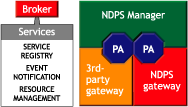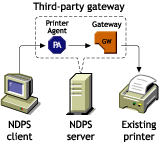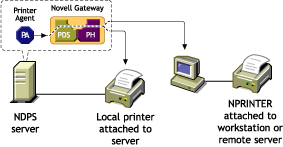
Gateways allow NDPS clients to send jobs to printers that are not NDPS-aware (that is, printers that are not equipped with embedded NDPS Printer Agents). You select and configure a printer gateway when you create a new Printer Agent.
Gateways translate NDPS queries or commands to printer-specific language that the physical printer can use. This is possible because gateways are configured to know the specific type (make and model) of printer being used.
The following diagram illustrates a typical gateway configuration.

Third-party gateways are developed by printer manufacturers to support printers directly attached to the network. Because these gateways are developed to interact with specific proprietary printers, they can provide a wider array of information and offer options that are not available for the generic Novell gateway. Some third-party gateways provide utilities that can be configured to automatically create Printer Agents when one of their printers is attached to the network.
For more information, see Selecting the Correct Gateway to Use.
The Novell gateway (illustrated below) supports LPR/LPD and IPP printing, local and remote printers, including those using NPRINTER or queue-based technology as well as those configured with RP mode enabled in IPX environments or LPR mode enabled in TCP/IP environments.

The Novell gateway is designed to be used with printers that don't have an embedded Printer Agent and don't yet have a proprietary, third-party gateway provided for them by their manufacturers.
RP printers are those that support Novell's legacy Remote Printer protocol. It is supported by many network-attached printers. LPR is a UNIX*-based printing protocol used by network-attached printers in TCP/IP environments to service jobs submitted to print queues.
For information about other major NDPS components, see the following: